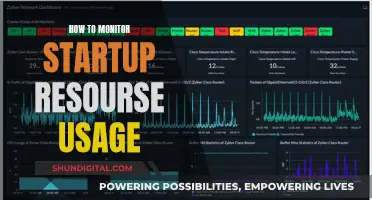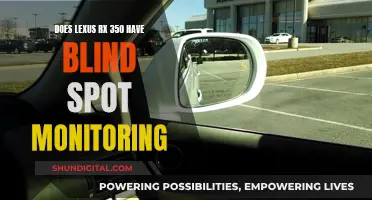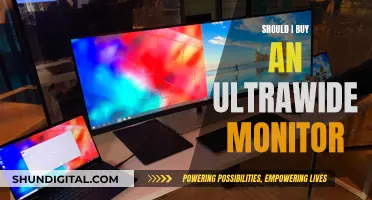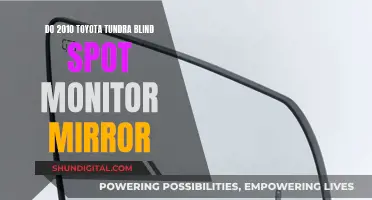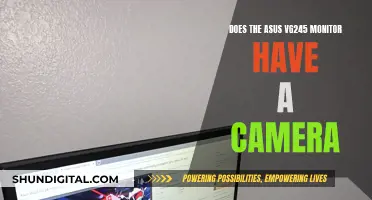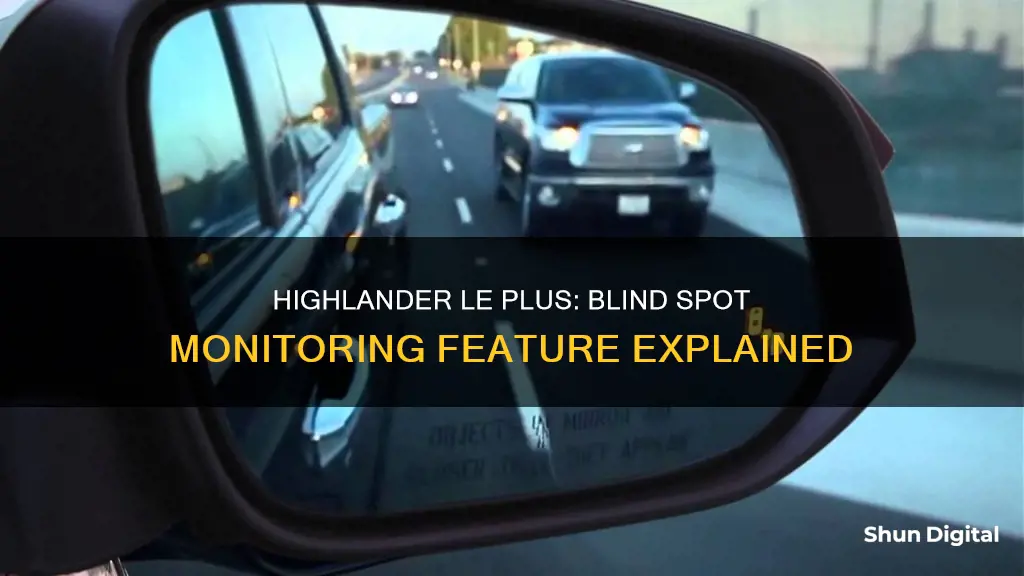
The Toyota Highlander is a popular car model that has been in production since at least 2019, with newer models released in 2021, 2023, and 2024. One of the key safety features that come with the Toyota Highlander is the Blind Spot Monitoring System (BSM), which includes a Blind Spot Monitor and a Rear Cross Traffic Alert. The BSM is designed to detect and notify the driver about vehicles in their blind spot, providing an extra pair of eyes and greater confidence when driving, especially when backing up or changing lanes. While the BSM system is meant to enhance safety, drivers are advised not to rely on it solely and should still use their turn signals and visually confirm their surroundings before making any manoeuvres.
What You'll Learn
- The blind spot monitor function uses radar sensors to detect vehicles in adjacent lanes
- The rear cross traffic alert function assists drivers when reversing
- The system has a common switch and indicator light
- The blind spot monitor is not designed to detect small vehicles, pedestrians, or vehicles in opposite directions
- The system may not function correctly in bad weather or when driving on wet surfaces

The blind spot monitor function uses radar sensors to detect vehicles in adjacent lanes
The Toyota Highlander is equipped with a Blind Spot Monitor (BSM) system that uses radar sensors to detect vehicles travelling in adjacent lanes that fall within the blind spot, i.e., areas that are not reflected in the side-view or rear-view mirrors. When a vehicle is detected in the blind spot, the BSM alerts the driver through an indicator on the outside rear-view mirror. This indicator flashes if the turn signal is operated when a vehicle is in the blind spot. The BSM system can be turned on or off using a switch, and it is operational when the vehicle's speed is above approximately 10 mph.
The BSM function has a detection range of approximately 11.5 ft. from the side of the vehicle (excluding the first 1.6 ft.), 9.8 ft. from the rear bumper, and 3.3 ft. forward of the rear bumper. It is important to note that the BSM is a supplementary function and should not be solely relied upon when making lane changes. The driver is responsible for safe driving and should always visually confirm their surroundings.
The BSM system may not function correctly under certain conditions, such as bad weather, ice or mud on the rear bumper, wet road surfaces, significant differences in speed or height between vehicles, consecutive steep inclines, wide vehicle lanes, and when towing a trailer. Additionally, the BSM may not detect small motorcycles, bicycles, pedestrians, vehicles travelling in the opposite direction, guardrails, walls, signs, parked vehicles, and similar stationary objects.
The 2023 Toyota Highlander Limited and the 2019 Toyota Highlander are among the models that feature the BSM system. The BSM system in the 2023 Highlander Limited has been reported to have some accuracy issues, with some owners reporting a 50% accuracy rate. However, others have found the system to be reliable, with no issues reported.
The BSM system in the Toyota Highlander is part of the vehicle's safety features, which also include the Rear Cross Traffic Alert (RCTA) system. The RCTA function assists the driver when backing up by detecting vehicles approaching from the right or left rear and providing visual and auditory alerts. Together, the BSM and RCTA functions provide drivers with an extra layer of awareness and confidence when changing lanes or reversing.
Monitoring Linux Memory Usage: Tracking a Process
You may want to see also

The rear cross traffic alert function assists drivers when reversing
The Toyota Highlander is a large vehicle, so it's important to have extra safety features to ensure safe driving. The rear cross-traffic alert function is one of the two functions of the blind spot monitor system. This function assists the driver when reversing by alerting them to vehicles approaching from either side. This is especially useful when backing out of a driveway, parking lot, or any other tight space.
The rear cross-traffic alert function uses radar sensors to detect vehicles that are approaching from the right or left rear of the Highlander. When a vehicle is detected, the driver is alerted through both visual and audio cues. The outside rearview mirror indicators will flash, and a buzzer will sound from behind the left-hand third seat. This helps to ensure that the driver is aware of the approaching vehicle, even if they have limited visibility or are unable to hear the buzzer due to loud noises.
The blind spot monitor system, including the rear cross-traffic alert function, can be turned on and off using a common switch. It is important to note that this system is not a replacement for safe driving practices. The driver is solely responsible for safe driving and should always be aware of their surroundings. The system is meant to complement the driver's own visual confirmation of safety and should not be overly relied upon.
The rear cross-traffic alert function has some limitations. For example, it may not work correctly during bad weather conditions such as heavy rain, fog, or snow. Additionally, the system may not detect vehicles correctly if there is ice or mud on the rear bumper or if the vehicle is driving on a wet road surface. It is also important to note that the system is not designed to detect small motorcycles, bicycles, or pedestrians.
Overall, the rear cross-traffic alert function of the blind spot monitor system in the Toyota Highlander can be a valuable tool for drivers, providing an extra layer of safety when reversing. However, it should be used in conjunction with other safety measures such as using turn signals and visually checking for vehicles.
Connect Instruments to Alto TX210: A Beginner's Guide
You may want to see also

The system has a common switch and indicator light
The Toyota Highlander's Blind Spot Monitoring System (BSM) is a welcome safety feature for drivers. It acts as an extra pair of eyes and ears, alerting drivers to vehicles in their blind spots and assisting them in making lane changes and reversing decisions. The BSM is composed of two main features: the Blind Spot Monitor and the Rear Cross Traffic Alert, which work together seamlessly.
The Blind Spot Monitor and the Rear Cross Traffic Alert share a common switch and indicator light, which is an important aspect of the system. This unified control and indicator design ensures that drivers can easily activate and monitor the status of both functions simultaneously. The switch, when set to "ON", illuminates the indicator light, providing a clear visual confirmation that the system is active and ready to support the driver. This simple yet effective design enhances the overall safety and convenience of the Toyota Highlander.
The common switch for the BSM is typically located on the dashboard, to the left of the steering wheel. This strategic placement allows for easy access and quick activation of the system. With a simple press or flip of the switch, drivers can ensure that they have an extra layer of protection while driving. The indicator light, often located near the switch, serves as a constant reminder that the system is active and functioning.
The indicator light plays a crucial role in the overall functionality of the BSM. When the system is turned on, the indicator illuminates, providing a visual confirmation that the BSM is operational. This visual cue reassures drivers that they can rely on the system to assist them in monitoring their blind spots effectively. Additionally, the indicator light works in tandem with the outside rearview mirror indicators, further enhancing the driver's awareness of their surroundings.
The outside rearview mirror indicators are another vital component of the BSM. When the system detects a vehicle in the blind spot, these indicators light up, drawing the driver's attention to the relevant side mirror. This visual alert is especially useful when a driver intends to change lanes. If the turn signal is activated and a vehicle is present in the blind spot, the indicator will flash, providing an urgent warning to the driver. This two-pronged approach of using both the common indicator and the side mirror indicators ensures that drivers receive clear and timely notifications.
In conclusion, the common switch and indicator light of the Toyota Highlander's Blind Spot Monitoring System play a crucial role in enhancing driver safety and confidence. The unified control and clear visual indicators ensure that drivers can easily operate and rely on the system. By activating the BSM, drivers benefit from the system's ability to detect vehicles in adjacent lanes and alert them through both visual and auditory cues. This comprehensive approach to monitoring blind spots empowers drivers to make better decisions and navigate the roads with greater peace of mind.
Hooking Up a Monitor: A Guide to Display Connections
You may want to see also

The blind spot monitor is not designed to detect small vehicles, pedestrians, or vehicles in opposite directions
The Toyota Highlander is equipped with a Blind Spot Monitor (BSM) system, which is designed to assist the driver when changing lanes and alert them to vehicles in their blind spot. The BSM uses radar sensors to detect vehicles in adjacent lanes that are not visible in the side mirrors. While this feature enhances safety, it is important to understand its limitations.
The blind spot monitor is not designed to detect small vehicles, pedestrians, or vehicles traveling in the opposite direction. This means that when changing lanes, the system may not alert you to motorcycles, bicycles, or oncoming traffic. The BSM is intended to supplement the driver's own visual confirmation and should not be solely relied upon. It is the driver's responsibility to remain vigilant and observe their surroundings at all times.
The BSM function has two operational modes: the blind spot monitor function and the rear cross-traffic alert function. The blind spot monitor function assists the driver when changing lanes, while the rear cross-traffic alert function assists when backing up. These functions use the same sensors and are turned on or off simultaneously using a common switch. When the system is turned on, an indicator illuminates, and a buzzer sounds.
The blind spot monitor function detects vehicles in the blind spot and alerts the driver through indicators on the outside rearview mirror. If a vehicle is detected in the blind spot, the indicator on the corresponding side mirror illuminates. When the turn signal is activated, the indicator flashes to draw the driver's attention to the potential hazard.
The rear cross-traffic alert function, on the other hand, assists the driver when reversing. It detects vehicles approaching from the right or left rear and provides both visual and auditory alerts. When a vehicle is detected, the side mirror indicators flash, and a buzzer sounds from behind the left-hand third seat.
While the BSM system offers valuable assistance, it is important to be aware of certain conditions that may affect its performance. For example, the system may not function correctly during heavy rain, fog, or snowy conditions. Additionally, if the sensors become obscured by ice, mud, or standing water, the system's accuracy may be compromised.
In conclusion, while the Toyota Highlander's Blind Spot Monitor system provides valuable assistance to drivers, it is crucial to understand its limitations. The system is not designed to detect small vehicles, pedestrians, or oncoming traffic. Therefore, drivers should always remain vigilant and use the system as a supplementary tool to their own visual confirmation.
Monitoring Resource Usage: Strategies for Optimal Performance
You may want to see also

The system may not function correctly in bad weather or when driving on wet surfaces
The Toyota Highlander is equipped with a Blind Spot Monitoring (BSM) system, which serves as an extra pair of eyes and ears for the driver. The BSM system is designed to warn the driver when there is a vehicle in the Highlander's blind spot on either side. It uses radar sensors to detect vehicles travelling in adjacent lanes that are not visible in the side mirrors. While this system is a valuable safety feature, it is important to understand its limitations and potential malfunctions.
One such limitation is that the BSM system may not function correctly in bad weather or when driving on wet surfaces. This includes conditions such as heavy rain, fog, or snow, which can interfere with the radar sensors and reduce their effectiveness. Additionally, driving on roads with standing water or other wet surfaces can also impact the system's performance. In such cases, the BSM system may not accurately detect vehicles in the blind spot, or it may provide false alerts.
It is crucial for drivers to understand that the BSM system is a supplementary aid and should not be solely relied upon. Even when the system is functioning optimally, it is the driver's responsibility to visually confirm the surroundings and make safe driving decisions. Overreliance on the BSM system could lead to accidents, especially when changing lanes or merging. Toyota advises drivers to use their own judgement and remain cautious, even when the BSM system is active.
To ensure the BSM system functions correctly, it is important to keep the sensors clean and free from any obstructions. Regular maintenance and cleaning of the sensors and the surrounding area on the bumper can help improve the system's performance. Additionally, drivers should be aware of other conditions that may impact the system's accuracy, such as differences in speed or height between vehicles, wide vehicle lanes, or when towing a trailer.
While the BSM system in the Toyota Highlander can provide valuable assistance, it is important to remember that it has limitations and may not function correctly in all conditions. Drivers should always remain vigilant and use their own visual confirmation to ensure safe driving, especially during bad weather or when driving on wet surfaces.
LCD Monitors: Understanding Their Most Accurate Statement
You may want to see also
Frequently asked questions
Yes, the Toyota Highlander LE Plus has blind spot monitoring.
The blind spot monitoring system uses radar sensors to detect vehicles in the driver's blind spot and alerts the driver through indicators on the outside rearview mirror.
Blind spot monitoring assists the driver in making lane changes and helps to avoid accidents.
Yes, the system may not function correctly in certain conditions, such as bad weather, dirty sensors, or when driving on wet road surfaces. It is important to not overly rely on the system and always visually confirm safety before changing lanes.
The blind spot monitoring system can be turned on or off using the BSM switch on the dashboard, typically located to the left of the steering wheel.


